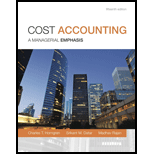
1.
Cost-Volume-Profit Analysis (CVP Analysis):
CVP Analysis is a tool of cost accounting that measures the effect of variation on operating profit and net income due to the variation in proportion of sales and product costs.
Break-Even Point:
Break-even point is a point of sales where company can cover all its variable and fixed costs. It is a point of sales where revenue generated is equal to the total costs. Thus, profit is zero at this level of sales.
Contribution Margin Percentage:
Contribution margin percentage is the excess of selling price over variable cost demonstrated in percentage.
To compute: Break-even point.
2.
To compute: Total contribution margin and operating income when 168,000 units are sold.
3.
To compute: Total contribution margin and operating income when 168,000 units are sold.
4.
To explain: Comparison between break-even point in point 1 and 3. Lower break-even points are not always better.
Want to see the full answer?
Check out a sample textbook solution
Chapter 3 Solutions
Cost Accounting, Student Value Edition (15th Edition)
- Accountingarrow_forwardUse this information to determine thearrow_forwardA California-based company had a raw materials inventory of $130,000 as of December 31, 2021, and $110,000 as of December 31, 2022. During 2022, the company purchased $175,000 of raw materials, incurred direct labor costs of $230,000, and incurred manufacturing overhead totaling $350,000. How much is the total manufacturing cost incurred by the company?arrow_forward
- Hello tutor solve this question accountingarrow_forwardA company uses the weighted-average method for inventory costing. At the end of the period, 19,500 units were in the ending Work in Process inventory and are 100% complete for materials and 72% complete for conversion. The equivalent costs per unit are; materials, $2.75, and conversion $2.40. Compute the cost that would be assigned to the ending Work in Process inventory for the period.arrow_forwardAccounting problemarrow_forward
- Accounting questionarrow_forwardDetermine the dollar value of goodwill in this acquisition of this financial accounting questionarrow_forwardAssume Bright Star Cleaning Services had a net income of $320 for the year. The beginning total assets were $5,500, and the ending total assets were $5,100. Calculate Bright Star Cleaning Service's return on assets (ROA).arrow_forward

 AccountingAccountingISBN:9781337272094Author:WARREN, Carl S., Reeve, James M., Duchac, Jonathan E.Publisher:Cengage Learning,
AccountingAccountingISBN:9781337272094Author:WARREN, Carl S., Reeve, James M., Duchac, Jonathan E.Publisher:Cengage Learning, Accounting Information SystemsAccountingISBN:9781337619202Author:Hall, James A.Publisher:Cengage Learning,
Accounting Information SystemsAccountingISBN:9781337619202Author:Hall, James A.Publisher:Cengage Learning, Horngren's Cost Accounting: A Managerial Emphasis...AccountingISBN:9780134475585Author:Srikant M. Datar, Madhav V. RajanPublisher:PEARSON
Horngren's Cost Accounting: A Managerial Emphasis...AccountingISBN:9780134475585Author:Srikant M. Datar, Madhav V. RajanPublisher:PEARSON Intermediate AccountingAccountingISBN:9781259722660Author:J. David Spiceland, Mark W. Nelson, Wayne M ThomasPublisher:McGraw-Hill Education
Intermediate AccountingAccountingISBN:9781259722660Author:J. David Spiceland, Mark W. Nelson, Wayne M ThomasPublisher:McGraw-Hill Education Financial and Managerial AccountingAccountingISBN:9781259726705Author:John J Wild, Ken W. Shaw, Barbara Chiappetta Fundamental Accounting PrinciplesPublisher:McGraw-Hill Education
Financial and Managerial AccountingAccountingISBN:9781259726705Author:John J Wild, Ken W. Shaw, Barbara Chiappetta Fundamental Accounting PrinciplesPublisher:McGraw-Hill Education





